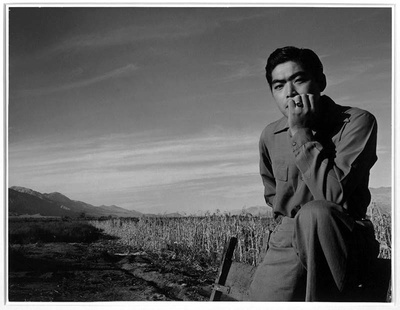When you are researching a topic, somehow relevant stories seem to appear all around you. So it was with this Wall Street Journal story today, on two photography sections in the newly renovated Oakland Museum of California. One is on the work of photographer Dorothea Lange, and one on Group f/64, a group of Bay Area photographers that included Ansel Adams, Edward Weston and Imogen Cunningham.
The two exhibitions highlight two opposing currents in the fertile Northern California photographic scene in the first half of the twentieth century. Lange, who learned her craft as a studio photographer, was radicalized by the poverty she witnessed during the Depression and the migrant farm workers she photographed for the Farm Security Administration. She viewed herself as a documentarian; technique was secondary to her attempt to honestly portray the dispossessed.
Adams and his group argued for a move beyond the romantic, gauzy Pictorialism of the nineteenth century, and for photography as a pure art form. It could be abstract, reflecting the modernist themes emerging in the fine art world at the time, or realistic depictions of nature that, like Adams’ work, reflected the timeless and the sublime through subtle and exact calibrations of framing, aperture, light and developing techniques.
William Meyers’ Journal article discusses the sometimes prickly friendship between Adams and Lange, described by Sandra S. Phillips, the senior curator of photography at the San Francisco Museum of Modern Art, as “a friendship with differences.” These differences were most obvious in Lange’s and Adams’ treatment of the World War II California concentration camp for Japanese Americans, Manzanar. Lange portrayed the sorrow, loss and injustice of the mass imprisonment (an example of her work above, left), while Adams (portrait from Manzanar, below)fashioned a positive image of the Japanese as “loyal Americans” displaying their mettle through obedience and elevated by the majesty of their high desert surroundings.
Meyers notes that the differences between the two photographers live on in their treatment of their photographic legacy. Lange wanted to make the personal archive she donated to the Oakland Museum—including 6,000 prints and 25,000 negatives—available to the public. Adams’ archive is held at the Center for Creative Photography at the University of Arizona, but is tightly controlled by the Ansel Adams Publishing Rights Trust.
Although Adams donated his Manzanar photographs to the Library of Congress, he omitted several iconic images he took on his Manzanar trip: Winter Sunrise, The Sierra Nevada, from Lone Pine California 1944 and Mount Williamson, Sierra Nevada, from Manzanar, California. These images had become a valuable source of income that Adams sought to protect.
In 1944 Adams published a cheaply printed, two-dollar paperback book of his Manzanar photos, Born Free and Equal. Featuring 64 photos and text he wrote himself, it was among the top-ten books sold in San Francisco that year, although it was poorly distributed beyond the Bay Area. In his later years, Adams claimed that the military had confiscated a large number of copies and destroyed them because of its perceived anti-Americanism. At the time of publication, some critics praised Adams for his moral courage while others vilified him for sympathizing with the enemy.
Perhaps as a result of the criticism received by Born Free and Equal or to keep the highly lucrative Adams’s legacy free of political taint, the Ansel Adams Publishing Rights Trust refused to approve the re-publication of Born Free and Equal in 2002 by the small California press Spotted Dog. This caused much anguish for publisher Wynne Benti, who recalled that the months she fought to complete the project as among the most difficult of her life. “I remember being at the UCLA book festival,” Benti told me. “People walked away and refused to buy the book because it was not approved by the trust.” In the end, Benti was forced to leave out Born Free and Equal’s powerful nature photographs.
Stay tuned. I am putting the finishing touches on my piece on Adams, Lange and Manzanar prisoner/photographer Toyo Miyatake and hope to make it available soon!
*This article was originally published on Nancy Matsumoto’s blog: Walking and Talking.
© 2010 Nancy Matsumoto







